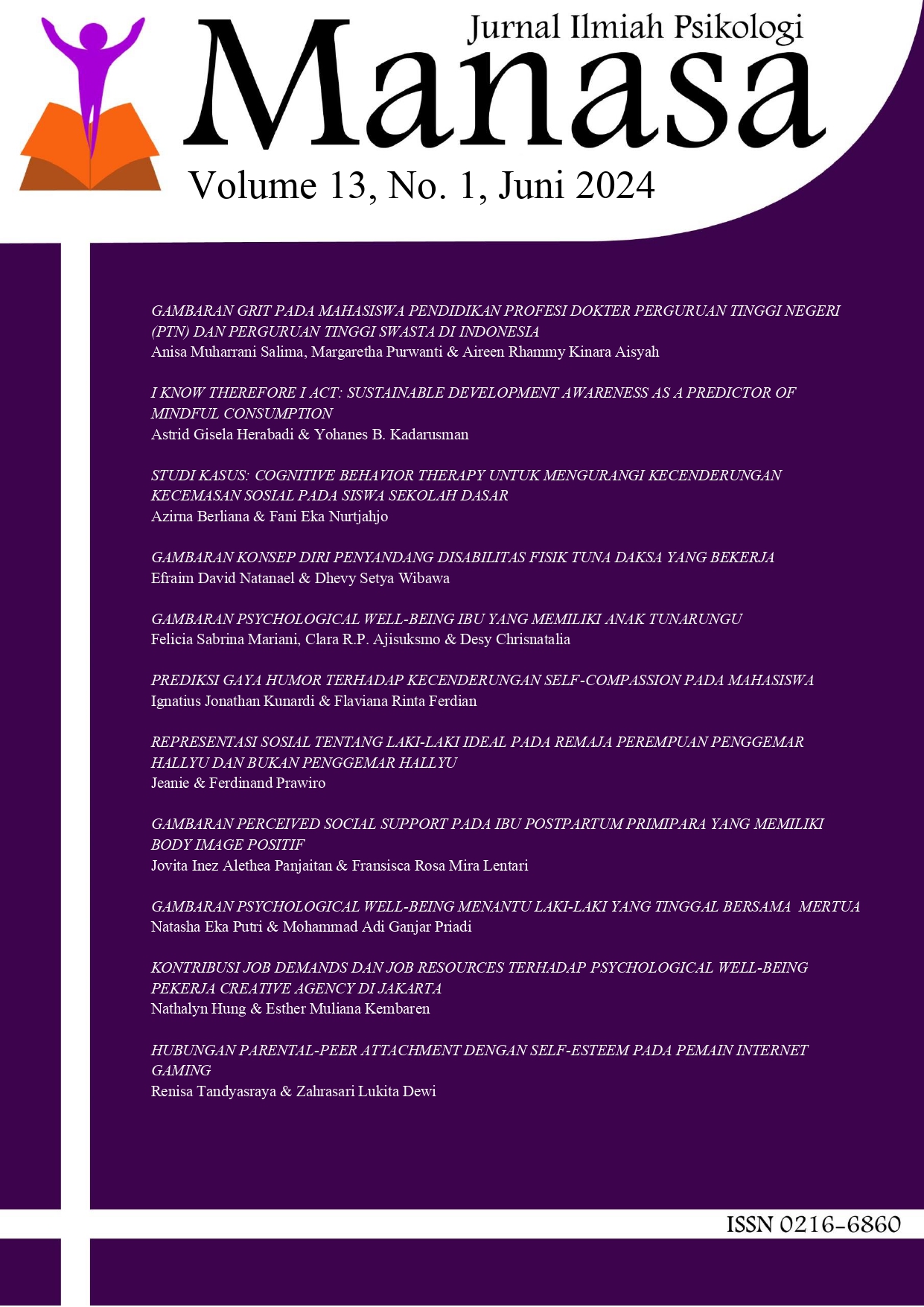REPRESENTASI SOSIAL TENTANG LAKI-LAKI IDEAL PADA REMAJA PEREMPUAN PENGGEMAR HALLYU DAN BUKAN PENGGEMAR HALLYU
DOI:
https://doi.org/10.25170/manasa.v13i1.5470Keywords:
social representation, ideal man, Hallyu fans, teenage girlsAbstract
The penetration of Hallyu culture in Indonesia is becoming increasingly widespread, as indicated by the growing popularity of K-pop, K-drama, K-movie, and K-variety shows. Hallyu culture can shift the perception of the ideal man in Indonesian society, especially among teenage girls. This study aims to compare the social representation of the ideal man between teenage girls who are fans of Hallyu and those who are not.
Data collection was conducted in two stages: a questionnaire using the word association method to identify social representation attributes, and a questionnaire using the double denial technique, which was tested using chi-square goodness of fit ⅔ expected frequency to determine central core and peripheral attributes. The first stage involved 220 participants with an average age of 16 years (SD = 1.73), while the second stage involved 235 participants with an average age of 17 years (SD = 2.57).
Overall, the results showed no difference in the social representation of the ideal man between the two groups, with nine central core attributes (i.e., well-behaved, intelligent and talented in various fields, affectionate to their partner, humorous, religious, committed to the relationship, caring for family, understanding, and able to control emotions) and two peripheral attributes (i.e., attractive appearance and financially stable).
References
Abric, J. (1996). Specific processes of social representations. Papers on Social Representations, 5(1), 77-80.Aoimirai. (2019). K-pop music video statistics. Aoimirai net. Diakses dari http://aoimirai.net/kpop/kpop_statistics.html
Beynon, J. (2002). Masculinities and Culture. PA: Open University Press.
Blattberg, E. (2015, April 24). The demographics of youtube, in 5 charts. Digiday. Diakses dari https://digiday.com/media/demographics-youtube-5-charts/
Davis, E. (1990). Representations of commonsense knowledge. CA: Morgan Kaufmann Publishers.
Dolot, A. (2018). The characteristic of generation z. E-mentor, 2(74), 44-50. Doi : https://doi.org/10.15219/em74.1351
Dunkel, C. S., Nedelec, J. L., Shackelford, T. K., & van der Linden, D. (2018). Cross-trait assortment for intelligence and physical attractiveness in a long-term mating context. Evolutionary Behavioral Sciences. Doi : 10.1037/ebs0000148
Flowerboys and the appeal of ‘soft masculinity’ in south korea. (2018 September 5). BBC News. Diakses dari https://www.bbc.com/news/world-asia-42499809
Greengross, G. (2011, Juni 2011). Are women more attracted to men who court them with humor?. Psychology Today. Diakses dari https://www.psychologytoday.com/intl/blog/humor-sapiens/201106/are-women-more-attracted-men-who-court-them-humor?quicktabs_5=0
Greengross, G. (2011, Oktober 14). Why jokes are seductive. Psychology Today. Diakses dari https://www.psychologytoday.com/us/blog/humor-sapiens/201110/why-jokes-are-seductive
Hall, J. A. (2015). Sexual selection and humor in courtship: A case for warmth and extroversion. Evolutionary Psychology, 1-10. Doi: https://doi.org/10.1177/1474704915598918
Höijer, B. (2011). Social representations theory: A new theory for media research. Nordicom Review, 32(2), 3-16.
Hone, L. S. E., Hurwitz, W., & Lieberman, D. (2015). Sex differences in preferences for humor: A replication, modification, and extension. Evolutionary Psychology, 13(1), 167-181. Diakses dari https://journals.sagepub.com/doi/pdf/10.1177/147470491501300110
Howarth, C. (2006). A social representation is not a quiet thing: Exploring the critical potential of social representations theory. British Journal of Social Psychology, 45, 65-86.
Korean Culture and Information Service. (n.d.). Hallyu (Korean Wave). Diakses dari http://www.korea.net/AboutKorea/Culture-and-the-Arts/Hallyu
Kruse, L., Weimer, R., & Wagner, F. (1988). What men and women are said to be: Social representation and language. Journal of Language and Social Psychology, 7(3-4), 243-262. https://doi.org/10.1177/0261927X8800700407
Landis, J.R., & Koch, G.G. (1977). The measurement of observer agreement for categorical data. Biometrics, 33(1), 159-174. Doi: 10.2307/2529310
Moliner, P. & Abric, J. (2015). Central core theory In Sammut, G., Andreouli, E., Gaskell, G., & Valsiner, J (Eds.). The Cambridge Handbook of Social Representations (pp. 83-95). Cambridge, United Kingdom: Cambridge University Press.
Moreira, R.M., Boery, E.N., Oliverira, D.C.de., Sales, Z.N., Boery, R.N.S.de.O., Teixeira, J.R.B., Ribeiro, I.J.S., & Mussi, F.C. (2015). Social representations of adolescents on quality of life: Structurally-based study. Ciência & Saúde Coletiva, 20(1), 49–56. Doi:10.1590/1413- 81232014201.20342013
Nurmila, N. (2015). Pengaruh budaya patriarki terhadap pemahaman agama dan pembentukan budaya. Karsa, 23(1), 1-16. Doi: 10.19105/karsa.v23i1.606
Praptika, Y., & Putra, G.M.N. (2016). The representation of masculinity in south koreaan reality show “the return of superman”. Allusion, 5(2), 155-172. Diakses dari http://journal.unair.ac.id/download-fullpapersallusion02fe801ab4full.pdf
Purkhardt, S.C. (2015). Transforming social representations: A social psychology of common sense and science. NY: Psychology Press.
Quenza, C. J. P. (2005). On the structural approach to social representations. Theory & Psychology, 15(1), 77-100. Doi: 10.1177/0959354305049746
Ramadhani, K., & Linadi, K.E. (2012). Korean wave and potential impacts on indonesian adolescents and other asean country. ASEAN/Asian Academic Society International Conference. Diakses dari http://aasic.org/proc/aasic/article/view/94/93
Sakina, A.I., & Siti, D.H.A. (2017). Menyoroti budaya patriarki di Indonesia. Social Work Jurnal, 7(1), 1-129. Doi: 10.24198/share.v7i1.13820
Salesses, L. & Romain, D. (2014). The imaginary and social representations generated by fashion images in women’s magazines. Papers on Social Representations, 23(2), 23.1-23.20. Diakses dari http://psr.iscteiul.pt/index.php/PSR/article/view/286/402
Sammut, G., Andreouli, E., Gaskell, G., & Valsiner, J. (2015). Social representations: A revolutionary paradigm? In Sammut, G., Andreouli, E., Gaskell, G., & Valsiner, J (Eds.). The Cambridge Handbook of Social Representations (pp. 3-11). Cambridge, United Kingdom: Cambridge University Press.
Schwieger, D., & Ladwig, C. (2018). Reaching and retaining the next generation: Adapting to the expectations of gen z in the classroom. Information Systems Education Journal, 16(3), 45-54. Diakses dari https://files.eric.ed.gov/fulltext/EJ1179303.pdf
Singleton, R., Carter, J., Alencar, T., Piñeirúa-Menéndez, A., & Winskell, K. (2018). Social representation of masculinity in mexican youth’s creative narratives. Boyhood Studied, 11(1), 63-81. Doi: 10.3167/bhs.2018.110105
Smith, N., & Joffe, H. (2012). How the public engages with global warming: A social representations approach. Public Understanding of Science, 22(1), 16–32. Doi:10.1177/0963662512440913
Statistics reveal genders and age groups attending seventeen, bts, and exo concerts. (2016, September 9). Koreaboo. Diakses dari https://www.koreaboo.com/news/age-and-gender-groups-at-exo-bts-and-seventeen-concerts/
Wachelke, J. (2012). Social representations: A review of theory and research from the structural approach. Universitas Psychologica, 11(3), 729-741. Diakses dari http://www.scielo.org.co/pdf/rups/v11n3/v11n3a04.pdf
Wagner, W., Duveen, G., Farr, R., Jovchelovitch, S., Lorenzi-Cioldi, F., Markova, I., & Rose, D. (1999). Theory and method of social representations. Asian Journal of Social Psychology, 2(1), 95-125.
Wulantari, R.A. (2017). Konstruksi dan reproduksi maskulinitas kelompok muda urban kelas menengah: Studi fenomenologi di antara penonton drama korea selatan). Jurnal Komunikasi Indonesia, 1(2). Doi: https://doi.org/10.7454/jki.v1i2.7820
Downloads
Published
Issue
Section
License
Copyright (c) 2024 MANASA

This work is licensed under a Creative Commons Attribution-NonCommercial-ShareAlike 4.0 International License.









.png)
.png)

